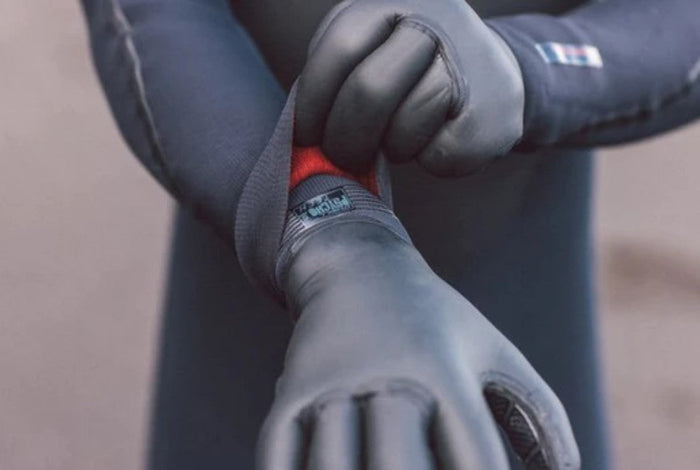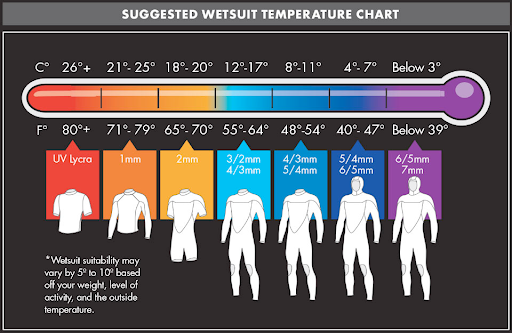What thickness wetsuit do I need at which water temperature?


The thickness of a wetsuit is measured in millimetres and is usually represented by two (or sometimes three) numbers. The first number refers to the thickness of the core and torso area, the second to the thickness of the extremities. A wetsuit with a thickness of 3/2 for example, has a 3 millimetre core and 2 millimetre arms and legs. The core is usually thicker, because it plays a key role in keeping your body warm. The arms and legs are thinner, in order to give you more freedom to move. A wetsuit with short arms and legs, also known as a shorty, usually has one thickness.
Tip: Remember that in addition to wetsuit thicknesses, the right wetsuit size is also very important!Therefore, also view our wetsuit size guide
Wetsuits are often categorised by season, because the seasons are directly related to the temperature of the water. But of course, you can also choose the right wetsuit thickness by looking at the water temperature alone. Have a look at the chart below to get an idea of what thickness wetsuit you need at which water temperatures. Please note that this is just a guideline and other factors also play a role.

| Wetsuit thickness women | Wetsuit thickness men | Wetsuit thickness kids | Temperature (℃) | Season |
|---|---|---|---|---|
26+ ℃ |
Summer |
|||
1 mm wetsuits |
1 mm wetsuits |
1 mm wetsuits |
21℃ - 25℃ |
Summer |
2mm wetsuits or shorty |
18℃ - 20℃ |
Spring / Summer |
||
12℃ - 17℃ |
Spring |
|||
8℃ - 11℃ |
Fall |
|||
5/4mm wetsuits or 6/5mm wetsuits |
4℃ - 7℃ |
Fall / Winter |
||
7+ mm wetsuits |
7+ mm wetsuits |
Below 3℃ |
Winter |
As you can see in the above chart, the thickness of wetsuits ranges from 1 mm to 6 or even 7 millimetres. Probably, you will be mostly using suits from the middle of the spectrum. A 2 mm shorty is suited for water temperatures between 18°and 20Celsius (65° -70°Fahrenheit), and is a great summer suit for the UK and the rest of Europe. In fall, when temperatures often range from 12°to 17°Celsius (55° -64°Fahrenheit), you can choose a wetsuit with a thickness of 3 mm around the core and 2 mm at the extremities, or a wetsuit with 4 mm around the core and 3 mm at the arms and legs – depending on how quickly you get cold and what kind of activity you perform. A 4/3 suit is also a good choice for temperatures ranging from 8°to 11°Celsius (48° -54°Fahrenheit), but in those conditions, you can also go for the added warmth of a 5/4 mm suit. In cold winter water, a hooded 5/4 mm suit is a must, along withsurf glovesandsurf bootsto keep your hands and feet warm.
Water temperature is an important factor in choosing a wetsuit, but not the only one. Wind chill and the activity of your choice are also important. The longer your body is above water and the more of your body that’s exposed, the more wind and air temperature affect your body heat. In surfing, swimming and bodyboarding, your body will be in the water most of the time, while in sports like windsurfing, kitesurfing and paddleboarding you'll be mostly out of the water. This means a surfer might prefer a thicker wetsuit in cold water temperatures and warmer air temperatures, while a windsurfer chooses a thinner wetsuit in the same conditions. At the same time, a surfer might choose a thinner suit for conditions with warm water and cooler air temperatures, while a windsurfer might prefer a thicker suit in those conditions.
So the bottomline is, that guidelines are useful, but you should find your own preferences and invest in a wetsuit quiver that allows you to go out in the water all year long!
3 comments
Hi Debbie,
If, in your case, the temperature of the water varies from the outside temperature we would recommend using a wetsuit specially designed for windy sports like kitesurfing, windsurfing or wakeboarding. You can find those here:
https://uk.oneill.com/collections/kite
The thickness of the wetsuit you need depends on the water temperature. You can use the table above to choose the right wetsuit.
If you need further assistance with choosing a wetsuit you can contact our customer support.
https://support.oneill.com/hc/en-us
Kind regards,
Team O’Neill Europe
Team O'Neill on
In situations where water and air temperatures vary significantly, what wetsuit thickness would provide the most comfort and protection for activities like surfing, windsurfing, or paddleboarding? Would a thicker wetsuit be too warm when out of the water, or a thinner wetsuit too cold while in the water?",
"refusal
Debbie Green on
Dear oneill.com administrator, You always provide useful tips and best practices.
Lydia Studer on